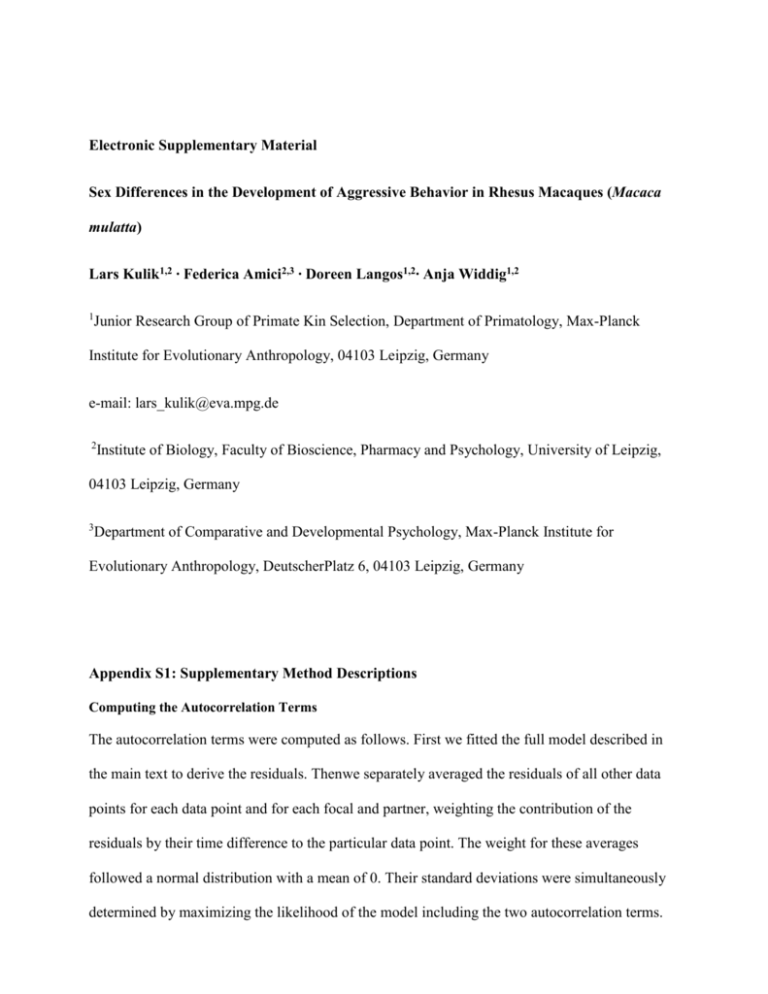Electronic Supplementary Material Sex Differences in the
advertisement

Electronic Supplementary Material Sex Differences in the Development of Aggressive Behavior in Rhesus Macaques (Macaca mulatta) Lars Kulik1,2 ∙ Federica Amici2,3 ∙ Doreen Langos1,2∙ Anja Widdig1,2 1 Junior Research Group of Primate Kin Selection, Department of Primatology, Max-Planck Institute for Evolutionary Anthropology, 04103 Leipzig, Germany e-mail: lars_kulik@eva.mpg.de 2 Institute of Biology, Faculty of Bioscience, Pharmacy and Psychology, University of Leipzig, 04103 Leipzig, Germany 3 Department of Comparative and Developmental Psychology, Max-Planck Institute for Evolutionary Anthropology, DeutscherPlatz 6, 04103 Leipzig, Germany Appendix S1: Supplementary Method Descriptions Computing the Autocorrelation Terms The autocorrelation terms were computed as follows. First we fitted the full model described in the main text to derive the residuals. Thenwe separately averaged the residuals of all other data points for each data point and for each focal and partner, weighting the contribution of the residuals by their time difference to the particular data point. The weight for these averages followed a normal distribution with a mean of 0. Their standard deviations were simultaneously determined by maximizing the likelihood of the model including the two autocorrelation terms. The calculation was performed using an R function written by Roger Mundry. The minimization of the Akaike’s information criterion (AIC) (Burnham and Anderson 2002) to find the best fitting standard deviations of the weighted function for the autocorrelation terms was performed using the R function “optim” from the package “stats.” Reference Burnham, K. P., & Anderson, D. R. (2002).Model selection and multimodel inference : A practical information-theoretic approach. New York: Springer Science+Business Media. Parentage Assignment and Determination of Kinship For parental assignment we used the long-term genetic database of this population, which was implemented in 1992 and continuously updated since then (Kulik et al. 2012; Nürnberg et al. 1998; Widdig et al. 2001, 2006). Almost the entire present population has been systematically sampled by collecting hair, blood, tissue, or fecal samples for DNA extraction. For our study, we were able to sample all 55 focal subjects plus 445 of all 522 individuals (95.79%)belonging to the study group. The database from the University of Leipzig (details in Widdig et al.unpubl. data) currently comprises 2404 individuals genotyped at 17.46 ± 3.51 loci on average (± SD) out of a total of 23 STR markers. Using CERVUS 3.0.8 (Kalinowski et al. 2007) we calculated the mean number of alleles per locus (7.48 ± 2.63), the mean observed heterozygosity across loci (0.73 ± 0.07), the mean polymorphic information content (0.69 ± 0.08), and the mean expected heterozygosity (0.73 ± 0.06). There was no evidence of null alleles occurring at these loci and all loci were in Hardy–Weinberg equilibrium. Maternity derived from long-term field observations was genetically tested if a sample was available. For all 55 focal subjects we were able to confirm the behaviorally assigned mother genetically. For paternity assignment, all males older than 1250 d(based on earliest age at reproduction(Bercovitch et al. 2003) and present on the island ≥200 d before a given infant’s birth (mean days ± SD of gestation length of 166.5 ± 7.4) were considered as potential sires for a given infant (mean days ± SD of gestation length of 166.5 ± 7.4; Silk et al. 1993). We were able to sample all potential sires (N= 167) from the entire island that fulfilled these criteria with respect to our focal cohort, which allowed us to alsoaccount for extra group paternity reported for the study population (Widdig et al. 2004). For our 55 focal subjects each mother–father–offspring trio was genotyped at 16.09 ± 2.91 (mean ± SD) common loci (and at least at 12 common loci). We determined paternity using a combination of exclusion and likelihood analyses as follows. In 53 cases, all potential sires were excluded on at least two loci, with the exception of the assigned sire, which matched the offspring–mother pair at all loci. In the remaining two cases, the assigned sire had no mismatch with the respective mother–offspring pair, but one other candidate sire could be excluded only at one locus. To confirm assigned paternities derived via exclusion, all paternities were additionally supported at the 95% confidence level in favor of the male with the highest LOD score calculated by CERVUS 3.0 (Kalinowski et al. 2007). We also aimed atassigning the maternal and paternal grandparents to increase the power of our kinship data. We were able to genetically confirm 54 of 55 behavioral maternal grandmothers of our focal subjects; for one behavioral grandmother we lacked a DNA sample. Given that only 1.41% of all behavioral mothers in the database were not confirmed genetically (potentially due to sample swaps, or misidentification of the behavioral mothers in the field, e.g. due to adoption or kidnapping), we felt confident to subsequently use the behaviorally assigned mother/grandmother when missing a DNA sample. Further, we were able to determine 51 of 55 maternal grandfathers, 50 of them by excluding all candidate sires on at least two loci, with the exception of the assigned sire. For one assigned grandfather, one other candidate sire could be excluded only at one locus; however, this grandfather was additionally confirmed at the 95% confidence level. Likewise, we were able to genetically confirm 47 of 55 paternal grandmothers, whereas for the others we were lacking a DNA sample and therefore subsequently used the behavioral grandmothers. Finally, we were able to determine a total of 50 of 55 paternal grandfathers by excluding all candidate sires on at least two loci, with the exception of the assigned sire. For two additional grandfathers, one other candidate sire could be excluded only at one locus; however, he was additionally confirmed at the 95% confidence level. We used the same procedure for all sampled potential social partners of our focal subjects (N=455). Genetically we were able to confirm 98.90% of behavioral mothers, 82.23% of maternal grandmothers, and 68.95% of paternal grandmothers of the focal partners. Further, we were able to determine 91.43% of fathers, 75.80% of maternal grandfathers, and 69.81% of paternal grandfathers. For those focal partners for which we were lacking a DNA sample we subsequently used the behaviorally assigned mothers/grandmothers. When other potential fathers/grandfathers were excluded with only one mismatch, we were able to confirm the assigned fathers/grandfathers at the 95% confidence level. Based on the parentage assignments in the preceding text, we used pedigree information up to the grandparental generation to establish kin relationship for all dyads, including one focal subject and one potential focal partner or two focal subjects, respectively. Restricting the data to those dyads in which both partners were present at the same time led to a total of 22,039 unique dyads in our dataset. Full pedigree information up to the grandparent generation comprising 12 IDs per dyad were available for 11,515 dyads. For an additional 4885 dyads with unknown sire/grandsire of an individual we used an exclusion procedure to ensure that a given dyad was unrelated. In this procedure we first identified all reproductive males (potential sires) on the island at the time of conception (using CPRC census records) of a given individual and then reduced the number by all males excluded as sires based on genotypic data. This provided a list of potential sires that could not be excluded, e.g., due to a lack of samples or power. We then compared the identities of the nonexcluded potential sires of a given subject A with the identities of the assigned sire and grandfathers of a second subject B. If we found no overlap, we considered this dyad unrelated. If an overlap occurred, an expected relatedness was calculated based on the probability of sharing one or several ancestors and accounting for the empirical level of inbreeding avoidance in this population (R script written by Roger Mundry and L. Kulik). In total we had 16,400 dyads (74.41%) for which pedigrees were completely available up to the grandparent generation. The remaining 5639 dyads (25.59%) had gaps in their genealogies, among which 71.01% were missing only two IDs and thus wekept them in our dataset. Based on the available pedigree information, we could classify 20,872 dyads (94.7 %) either as 1) maternal kin: 794 dyads (3.80%), 2) paternal kin: 907 dyads (4.35%) or 3) nonkin: 19,171 dyads (91.85%). As the remaining dyads were related over both the maternal and paternal lines, we excluded them from the analyses for reasons explained elsewhere (Albers and Widdig 2013). As maternal kin we considered dyads that were related only over the maternal line, i.e., dyads that shared the same mother and/or maternal grandmother. We excluded 55 focal–mother dyads from this analysis as mother–offspring bonds represent the strongest social bonds within rhesus groups (Schülke et al. 2013). Within our maternal kin, we found 180 half-siblings related at r=0.25, 37 grandparent/grandchild dyads related at r= 0.25, 276 aunt/uncle–nephew/niece dyads related at r=0.125 and 301 cousins, related at r=0.0625. Paternal kin comprised dyads that were related only over the paternal line, i.e., dyads that shared the same father and/or paternal grandfather. Within paternal kin we determined 50 sire–infant dyads related at r= 0.50 (5 sire–infant dyads were not considered, because the sire was not a group member during our study due to death or migration), 497 half-siblings related at r=0.25, 16 grandparent/grandchild dyads related at r= 0.25, 165 aunt/uncle–nephew/niece dyads related at r=0.125 and 179 cousins, related at r=0.0625. As nonkin we considered all dyads that were not related over both kin lines for a minimum of two generations, i.e., dyads that did not share a common individual among their parents or grandparents. References Albers, M., & Widdig, A. (2013). The influence of kinship on familiar natal migrant rhesus macaques (Macaca mulatta). International Journal of Primatology, 34, 99–114. Bercovitch, F. B., Widdig, A., Trefilov, A., Kessler, M. J., Berard, J. D., Schmidtke, J., Nurnberg, P., & Krawczak, M. (2003). A longitudinal study of age-specific reproductive output and body condition among male rhesus macaques, Macaca mulatta. Naturwissenschaften, 90, 309–312. Burnham, K. P., & Anderson, D. R. (2002). Model selection and multimodel inference : A practical information-theoretic approach. New York: Springer Science+Business Media. Kalinowski, S. T., Taper, M. L., & Marshall, T. C. (2007). Revising how the computer program CERVUS accommodates genotyping error increases success in paternity assignment. Molecular Ecology, 16, 1099–1106. Kulik, L., Muniz, L., Mundry, R., & Widdig, A. (2012). Patterns of interventions and the effect of coalitions and sociality on male fitness. Molecular Ecology, 21, 699–714. Nürnberg, P., Sauermann, U., Kayser, M., Lanfer, C., Manz, E., Widdig, A., Berard, J., Bercovitch, F. B., Kessler, M., Schmidtke, J., & Krawczak, M. (1998). Paternity assessment in rhesus macaques (Macaca mulatta): Multilocus DNA fingerprinting and PCR marker typing. American Journal of Primatology, 44, 1–18. Schülke, O., Wenzel, S., & Ostner, J. (2013). Paternal relatedness predicts the strength of social bonds among female rhesus macaques. PLoS ONE, 8, e59789. Silk, J. B., Short, J., Roberts, J., & Kusnitz, J. (1993). Gestation length in rhesus macaques (Macaca mulatta). International Journal of Primatology, 14, 95–104. Widdig, A., Bercovitch, F. B., Streich, W. J., Sauermann, U., Nürnberg, P., & Krawczak, M. (2004). A longitudinal analysis of reproductive skew in male rhesus macaques. Proceedings of the Royal Society of London B: Biological Sciences, 271, 819–826. Widdig, A., Nürnberg, P., Krawczak, M., Streich, W. J., & Bercovitch, F. B. (2001). Paternal relatedness and age proximity regulate social relationships among adult female rhesus macaques. Proceedings of the National Academy of Sciences of the USA, 98, 13769– 13773. Widdig, A., Streich, W. J., Nürnberg, P., Croucher, P. J. P., Bercovitch, F. B., & Krawczak, M. (2006). Paternal kin bias in the agonistic interventions of adult female rhesus macaques (Macaca mulatta). Behavioral Ecology and Sociobiology, 61, 205–214.








